By Sonja Heyck-Merlin
A farm is the sum of decisions. Long-term strategic and on-the-fly decisions. Decisions that induce arguments and ones requiring risk. They can be based on emotion. And some decisions are rooted in childhood experiences — as is the case with the owners of Moodytown Gardens in Palmyra, Maine. Johanna Burdet, or Jo as she goes by, and her husband Jarret Haiss were both born and raised in central Maine, only 20 miles apart, although they wouldn’t meet until they were adults. “We both kind of grew up in a back-to-the-land setting,” Burdet says. “Our parents had pretty serious vegetable gardens. An interest was sparked when we were young.”
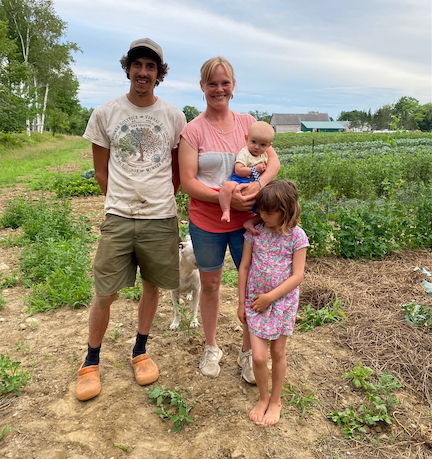
Of course, there are many people imprinted with the taste of a fresh carrot wiped clean on a pant leg that don’t choose to become farmers. But as children Burdet and Haiss ingested not just the fresh carrots but values — a love of physical labor, access to high-quality food and the importance of land stewardship. For them, these values stuck. At 19, Burdet studied abroad and WWOOFed (shorthand for participants in World Wide Opportunities on Organic Farms) in New Zealand, which affirmed her decision to transfer to Sterling College in Vermont to study sustainable agriculture. After high school, Haiss moved to North Carolina where the booming farmers’ markets sparked his interest in vegetable production.
When they were in their mid-20s, both opted to return to central Maine and work on organic farms. At the Downtown Waterville Farmers’ Market, selling for their respective employers, their paths converged. By the end of the season, they were tilling up gardens on Burdet’s parent’s land in Cornville, about 6 miles north of Skowhegan. Starting this business, named Moodytown Gardens (after the name of the road Burdet grew up on), triggered an avalanche of decisions.
The 2010 growing season was their first together. “It was 1 ½ acres at my parent’s place. We did a small CSA [Community Supported Agriculture program], wrote fliers by hand, copied them and stuck them in the neighbors’ mailboxes. We got into the Farmington and Belgrade Lakes farmers’ markets and found some small wholesale accounts,” Burdet says. Without much equipment, they worked by hand, their youthful backs and idealism propelling them forward. Their second season, they expanded onto some leased land, increasing their operation to 3 acres and added the Skowhegan farmers’ market and more wholesale accounts.
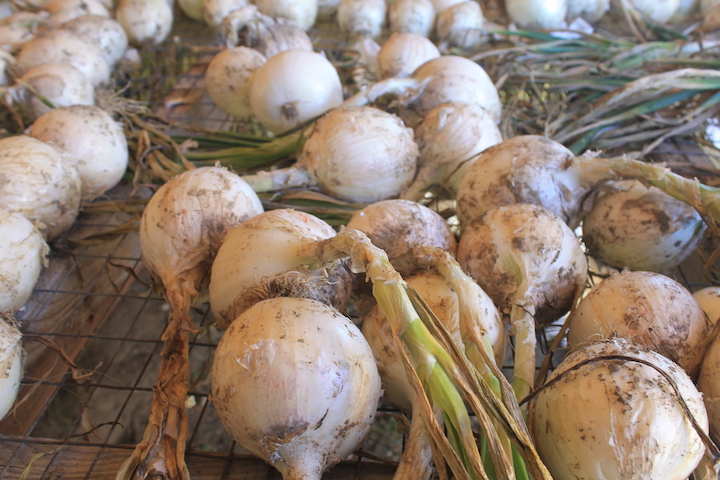
Although the gardens and their business venture flourished, Haiss says that ultimately “it was just not suitable for the kind of vegetable farming we wanted to do.” They’d always had their eyes peeled for a farm to purchase, and in 2012 it came along — 75 flat south-facing acres in Palmyra with a classic New England farmhouse and an attached 40-by-100-foot barn. The primary soil type is Bangor silt loam, which according to Haiss holds water and nutrients well. Because of this, they haven’t yet had to invest in irrigation equipment.
Twenty of the acres are open, with about 13 acres of contiguous tillable land lying to the north of their house and barn. It has taken a few years, but most of the crop rows have a standardized length of 200 feet. The remaining 7 acres are used to pasture pigs and beef cows. In their first year at the farm, Burdet and Haiss expanded to 6 acres in vegetable production. They also started renovating the house, jacking the barn and rejuvenating the soil, which was neglected from seven years of abandonment, followed by a year of conventional corn production.
As the farm evolved, it grew to include children (Tiger Rose born in 2015 and Heinz in 2021), buildings, a larger land base, more equipment and hired help. Burdet says, “Some overarching goals that inform our decisions are to treat our employees well, to improve our land, soil and buildings, to be present with our family and to make a living.”
Simplification is at the heart of many of their decisions, like the one to reduce the acreage in vegetable production from 6 to 4 1/2 acres. Haiss says, “That’s the sweet spot with our current equipment, practices and crew. The more we grow the more we have to hire and the more costs we have.” Even this reduced acreage demands three or four full-time workers each year: a combination of MOFGA apprentices who live on the farm in wall tents and share an outdoor kitchen and locals who commute to the farm.
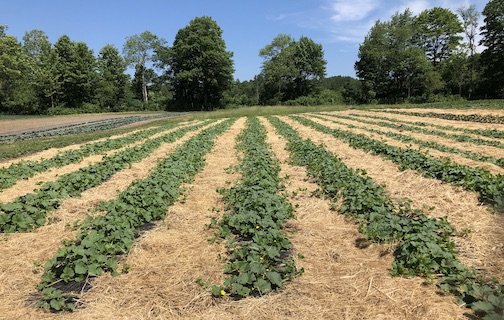
Another decision made in the name of simplicity was to mechanize. It was an easy choice, in part, because Haiss loves equipment and is adept at repairing it. For him, a winter day isn’t complete without scrolling through Craigslist’s equipment listing. “We have a hybrid method between intensive and mechanical methods,” Burdet says. “We’re learning how to match our planting style with the mechanical advantages that we now have.” Even though they are increasingly using machines, the weed pressure is significant, requiring a lot of hand labor.
Field prep is done mostly with three-point hitch implements, but they occasionally use a PTO-powered rototiller. They also use a three-bottom plow, disc harrow and spring-tooth harrow depending on field conditions such as weed pressure, whether the field was in a cover crop, and the desired fineness of the seed bed.
After tillage and fertilization (they spread a 5-3-8 organic granular fertilizer at a rate of 500 pounds per acre), they lay plastic mulch with a Buckeye 1912D for cucurbits, tomatoes, Swiss chard and brassicas. Between the crop rows, they mulch with square bales of dry hay produced on the farm.
For crops not planted into plastic mulch, such as potatoes, corn and roots, they now leave 30 inches between rows. Burdet says they used to “cram stuff really close together,” but the extra space allows them to cultivate certain crops and the pathways with a Farmall Super C, which has a variety of attachments that can be spaced in 6-inch increments.
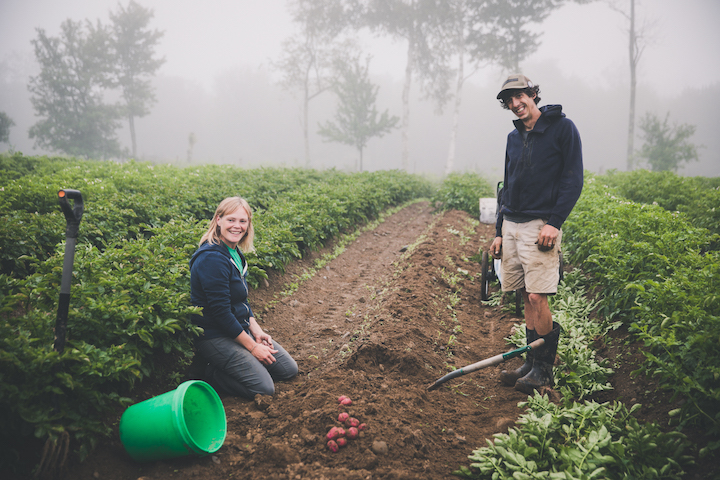
Carrots, for example, now grow in ridges that look like a potato hill with a flat top, seeded in a wide band with one row per ridge, rather than grown in a wide bed with multiple rows. Haiss, who does most of the tractor work, cultivates between the ridges, throwing soil on the hill and covering the weeds. Looking ahead, they can see adding a tractor-pulled seeder to this system to further increase efficiency. Burdet currently does all the direct seeding with a single-row EarthWay push seeder.
In 2021, they added a ride-behind Rain-Flo water wheel transplanter to the equipment lineup. “The transplanter helped us put more onions in the ground. We’re also playing around with direct seeding winter squash and other large seeds with the transplanter instead of doing it by hand,” Burdet says. They also have a Bomet single-row PTO-powered potato digger with a vibrating hopper that sifts soil from the potatoes.

A mix of Winter Luxury and New England Pie pumpkins. Holli Cederholm photo
Their decision to reduce both the number of crops grown but also how many varieties of each was also made in the pursuit of simplicity. “We have focused on what we grow well and what we enjoy,” Burdet says. “We’re not as diverse as we were five years ago. We’re down to 23 different vegetable crops instead of 40.” Rather than growing four varieties each of summer squash and zucchini, for example, they grow two of each. For tomatoes, potatoes and winter squash, Burdet keeps it to eight varieties.
This strategy is easier on their workers and, according to Burdet, easier on customers. “We used to think that everyone needed a lot of variety, but now we’re realizing that our customers like less choice,” Burdet says. In her opinion, customers don’t want to decide which of 14 types of tomatoes to buy. They are happy with a simpler choice, like should they buy a yellow or a red tomato.
By focusing on what they grow well, Burdet and Haiss are able to provide a consistent, quality product for their farmstand, 40-member CSA, two farmers’ markets (Skowhegan and Belgrade Lakes) and wholesale accounts. It’s more efficient, for instance, to offer larger quantities of a few crops to the Mainers Feeding Mainers food assistance program of which they are participants.
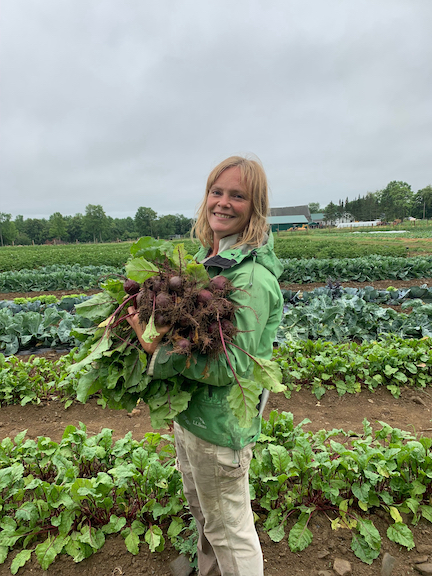
Burdet harvesting beets, one of the 23 crops grown on the farm. Courtesy of Moodytown Gardens
Growing 23 different vegetable crops and juggling four separate marketing channels is an intense and demanding proposition, preparing for farmers’ markets particularly so. Farmers’ markets aren’t simple affairs. The van has to be loaded, then driven down the bumpy coffee-spilling roads to market. The tent has to be erected, the van unloaded, the display fussed with and then the farmers must show an upbeat attitude for customers. And when the market is over, each step must be done in reverse.
Burdet and Haiss are pros at selling produce at their two markets, which provide 25% of their gross revenue. They also connect with their WIC and Maine Harvest Bucks customers at market. There is a tremendous trade-off, however, to family life. “We don’t get our weekends. This means no camping, no weddings, no family gatherings,” Burdet says.
Trying to reach an equilibrium between farm and family sometimes requires a recalibration. Although Burdet acknowledges the risk, a three- to five-year goal is to establish some large wholesale accounts, allowing them to reduce or eliminate farmers’ markets. Currently, 32% of their gross income is from wholesale accounts. “We’ve relied on markets for so long, with a lot of loyal customers, that it’s scary to let go of that. We’re at the point in our development though that I am confident our food will be sold if we are at market or not,” Burdet says.
Eliminating farmers’ markets is intimidating but achievable with a well-laid strategy. Decisions can’t always be made on the basis of economics or simplicity however; sometimes it’s a more visceral process.
Such is the case with the livestock on the farm. Burdet and Haiss have raised up to 30 pigs per year, born from their own sows, but in the last few years have only raised 15. The number ebbs and flows depending on their success. Burdet says, “Our demand for pork is very high, and we have struggled with consistency in our breeding program and have not been able to keep up with demand, especially since COVID.” The pigs do, however, complement their land-clearing projects and provide diversity at their farmstand and farmers’ markets.
Starting their beef herd of nine Angus-Hereford crosses made sense in some ways. There is plenty of pasture on the farm, they put up their own hay and the winter supply of manure provides fertility for the vegetable operation. Plus, Burdet says her husband enjoys doing something different after so many years of vegetable farming. Haiss is invested in the cows — he installed high-tensile fencing around the pasture behind the barn and has spent the past few winters clearing more land. So far they’ve only butchered three animals because they keep getting heifers. “Why just butcher off the moms?” Haiss asks.
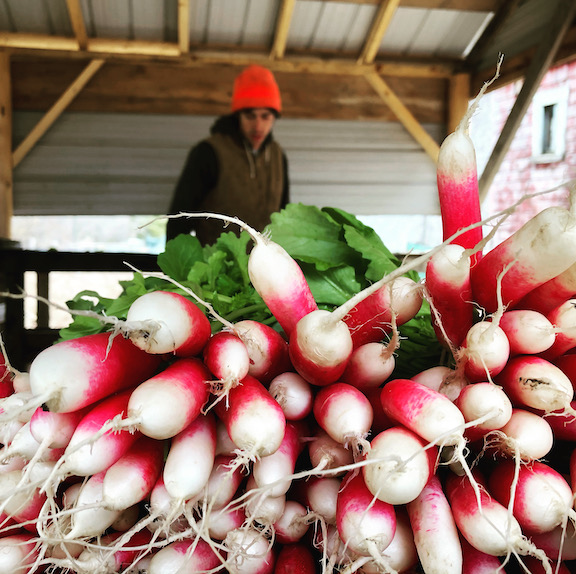
In other ways, the cows don’t make sense. Winter chores are time-consuming and the animals eat 1,200 bales a year that could be sold to horse owners at $8 per bale. (Haiss puts up between 4,500 and 6,000 square bales of dry hay a year on 100 acres of leased land, providing about 17% of the farm’s gross income.) So far, the cows are a large investment with little economic return.
The couple is batting around their plans for the cows. The same goes for what to do with their huge old barn and the design of a new wash and pack building if they get the funding for it. They must also decide whether or not to send their toddler to daycare next season. Then there’s the questions of what kind of seeder to buy and how to improve the fertility of their leased hay fields since they can no longer get chicken manure. Saving for retirement looms in the back of their minds.
“I sometimes second guess our strength as farm mentors and fear our apprentices could be learning more elsewhere. However, when folks fully absorb themselves in our farm and the ups and downs and the sometimes relentlessness of it all and realize they want to do this perhaps for the rest of their life, that feels amazing and like we are doing something right,” Burdet wrote in a 2021 Facebook post bidding farewell to two apprentices.
Moodytown Gardens is the sum of more than a decade of decision making. Decisions shaped by experience, simplicity, goals and sometimes emotion. The “the ups and downs” and “relentlessness of it all” are the byproducts of the choices behind juggling a farm and a young family. The tangible evidence of their choices — vibrant market displays and CSA boxes of vivid fresh produce — prove that they are certainly doing something right. Sure, there are missteps and miscalculations, but Moodytown is a successful example of 10 years of thoughtful deliberations and commitment to nourishing the people of Maine.
About the author: Sonja Heyck-Merlin is a regular feature writer for The MOF&G. She and her family own and operate an organic dairy farm in Charleston, Maine.
